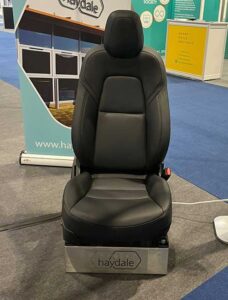How Graphene heater inks are driving automotive heat seating innovation
The evolution of automotive technology is a continuous pursuit of efficiency, comfort, and innovation. One of the most recent advancements in the field promises to revolutionize how we think about in-car comfort and energy efficiency: the integration of graphene heater inks into heated seating. This approach isn’t simply novel; it’s a cutting-edge yet fully realised solution poised to take pole position in the race to innovate automotive heating systems. This blog will explore how the world’s first graphene heater ink system compares to the more traditional approach.
The Traditional Approach: Wired Heaters
Traditional heated seats rely on wired heater mats, which involve stitching wires onto a thick, non-woven fabric. This fabric is then adhered to the seat foam using double-sided tape. A thick layer of insulating fabric is placed between the heater and the seat leather, requiring the heater to reach around 90°C to achieve a seat surface temperature of 43°C.
The specifications for a typical wired heater system include:
- Resistance: 1.2 ohms
- Voltage: 12 volts
- Current: 7.3 amps
- Power: 88 watts
- Heater temperature: 94.6°C
- Seat surface temperature: 43°C
Despite their widespread use, these systems have significant drawbacks. They require high power consumption, can create uneven heating, and are relatively inefficient due to the multiple layers involved in heat transfer. This inefficiency necessitates higher operating temperatures, which in turn demand more energy.
The Graphene Revolution
 Enter graphene heater inks, a cutting-edge solution pioneered by Haydale. Graphene, a single layer of carbon atoms arranged in a hexagonal lattice, is renowned for its exceptional thermal and electrical conductivity. When applied as a heater ink, graphene offers many advantages over traditional wired systems.
Enter graphene heater inks, a cutting-edge solution pioneered by Haydale. Graphene, a single layer of carbon atoms arranged in a hexagonal lattice, is renowned for its exceptional thermal and electrical conductivity. When applied as a heater ink, graphene offers many advantages over traditional wired systems.
The Haydale Graphene Heating solution applies conductive ink to a substrate that applies directly to the B surface within the seat production process. This method eliminates the need for additional wiring or insulating fabrics, resulting in a much more streamlined and efficient heating process. The graphene heater operates with significantly lower power requirements while maintaining effective heat output:
- Resistance: 4 ohms
- Voltage: 12 volts
- Current: 2.4 amps
- Power: 28 watts
- Heater temperature: 54°C
In a comparative test, the graphene heater achieved a uniform seat surface temperature of 43.4°C at just 8 volts, reducing the power output to merely 15.2 watts. This is a striking contrast to the 88 watts required by traditional wired heaters to achieve the same surface temperature, making the graphene solution up to six times more energy-efficient.
Benefits of Graphene Heater Inks
Energy Efficiency
The primary advantage of graphene heater inks is their remarkable energy efficiency. The heaters can operate at lower temperatures while still providing the desired warmth, conserving energy and reducing overall power consumption. The desired heat also stays warm longer than traditional heater wired elements again reducing the draw of energy from the battery.
Uniform Heating
Graphene heaters also offer more uniform heating compared to traditional wired systems. The even distribution of the heating ink ensures consistent warmth across the entire seat surface, eliminating hot spots and enhancing passenger comfort.
Versatility
The flexibility of graphene heater inks extends beyond seating. This technology can be applied to various vehicle interior surfaces, including door panels, dashboard facias, roof liners, and armrests. The vast potential applications offer comprehensive heating solutions that enhance the overall driving experience.
Durability and Safety
Graphene heater inks are coated with a tough, automotive-grade polyurethane (PU) leather coating. This not only protects the conductive heating ink but also replaces the need for sub-heating wire units, adding to the system’s durability and safety. The robust coating ensures longevity and reliability, essential for automotive applications.
Driving Innovation at Haydale
At Haydale, we are pioneering enormous automotive heating innovations with our advanced graphene heater inks. These inks deliver superior energy efficiency and uniform heating and offer remarkable versatility and enhanced durability, making them a transformative technology in the automotive industry.
As car manufacturers strive to improve energy efficiency and passenger comfort, our graphene heater inks provide a promising pathway toward a warmer, more efficient future on the road. With the evolution of transport to a more environmentally friendly electric offering, the need to minimise any energy use (like seat and cabin heating) will deliver a greater driving range, which is the holy grail for OEMs.
Explore how Haydale is turning up the heat in automotive comfort and efficiency. Contact a team member today to revolutionize your automotive heating needs.
